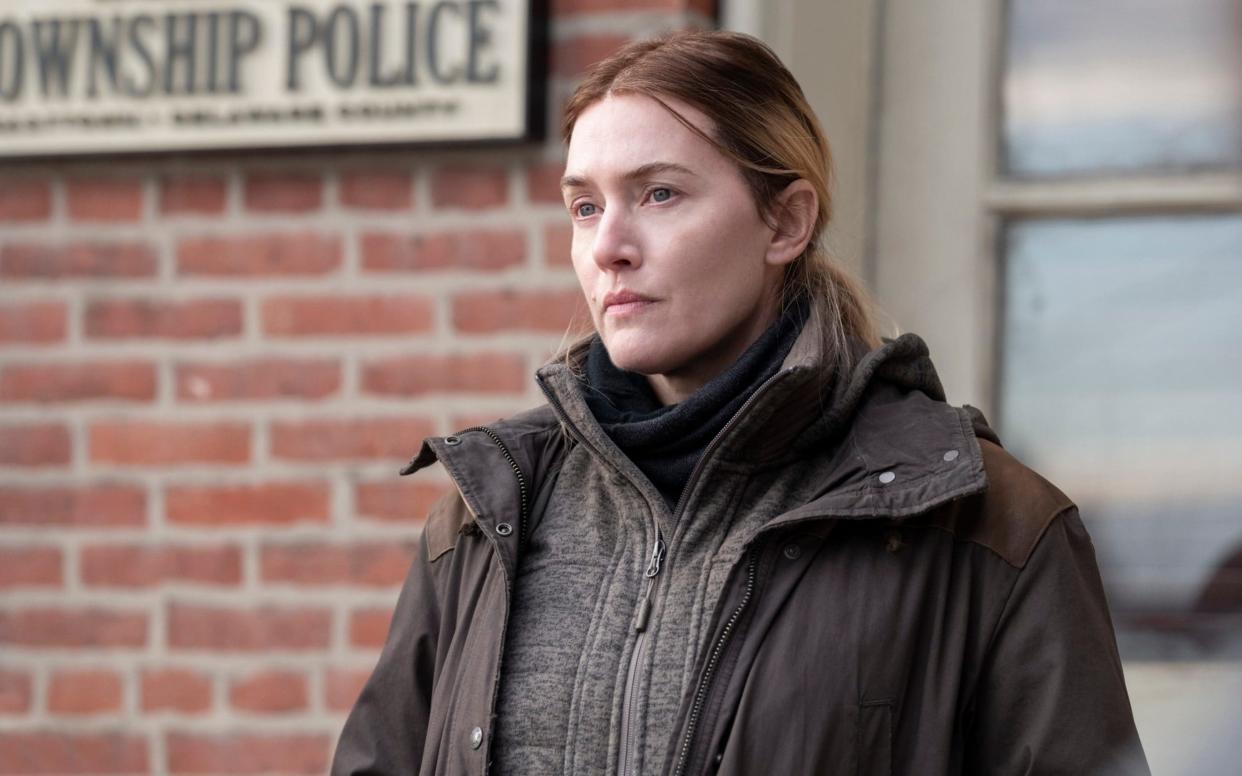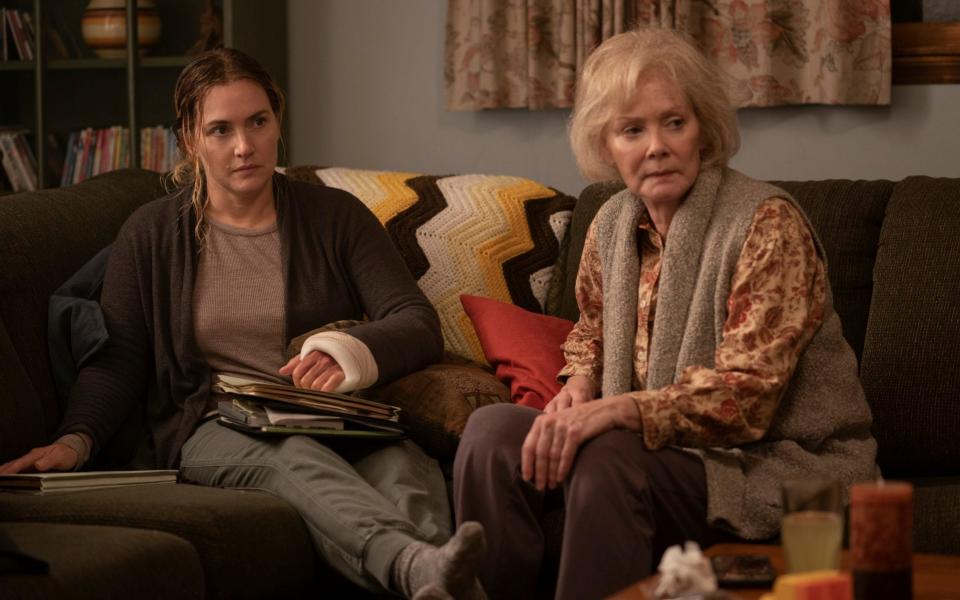'Kate threw things': Kate Winslet's dialect coach on how she perfected Mare of Easttown's 'Delco' accent

- Oops!Something went wrong.Please try again later.
- Oops!Something went wrong.Please try again later.
Susan Hegarty has been working with Kate Winslet ever since Titanic. Her job title is dialect coach – specifically, to help Winslet go from her native English accent to whatever fiendish elocution the next movie or TV series demands. From Oscar-winning German (The Reader) to an Armenian-Polish hybrid (Steve Jobs), it’s Hegarty who gets Winslet minding her Ps and Qs. But Mare Sheehan in HBO’s Mare of Easttown, the detective from Delaware County, Pennsylvania, who pronounces ‘daughter’ to rhyme with ‘murder’ and then says ‘sad’ as if she’s from the Home Counties, has been Hegarty and Winslet’s toughest nut to crack.
“It’s set in a small community that is part of suburban Philadelphia,” says Hegarty. “My impression as an American is that this accent has just never been part of the zeitgeist: most Americans don't know what it is, they've never heard it before. It's never been portrayed in any type of popular culture.”
Which is why it’s caused some confusion. A few weeks ago Saturday Night Live even honoured Mare of Easttown with a skit gently mocking the characters "Delco" mode of speech. Social media, as usual, has been more damning, with plenty of keyboard warriors bemused or even appalled at Winslet’s vowel sounds. Some have suggested that the accent is just a misfire.
“That annoys me,” says Hegarty. “Somebody wrote something saying, ‘Oh, well, she's doing this whole thing, but she's not really successful, you can hear the British coming out.’ I thought, ‘There's one thing I can tell you: she sure the heck did not sound British.’ And then I thought, ‘I bet it’s because of that Pennsylvania sound.’”
We’ll come back to what that Pennsylvania sound is, but first, in light of the specificity of the accent and the inevitable attention it would garner, why did they bother? Would most viewers have noticed if Winslet’s accent wasn’t 100% Delco, given that most viewers wouldn’t know what Delco sounds like? “I've been working with Kate for 25 years,” counters Hegarty, “and I know that Kate doesn't do things that are not spot on.”

One of the series’ producers told Hegarty that she was the second person to be hired on the project, right after Winslet. Winslet is an executive producer: the implication is that she insisted on getting the accent right – along with the clothes, the hair and the make-up, or lack of - as a precondition to signing up.
“It's just that's what she does,” says Hegarty. “If she's gonna do it, she knows that she needs to do the work that she and I have done over many years in order to do it properly. She wanted to give the reality and the groundedness of the culture the respect they deserve.”
Hegarty and Winslet’s process always starts with audio tapes of real voices. For Mare, they listened to recordings of writer Brad Ingelsby’s wife, who is a native of one of the towns that is a model for Easttown. (Confusingly, there is a real Easttown not that far from Delaware County but it’s not the model for the fictional Easttown. “It’s just Brad liked the name,” says Hegarty.)
The show also hired a local dialect coach named Susanne Selby who recorded dozens of native voices to give to the various other actors in the piece. (Hegarty worked exclusively with Winslet and James McArdle, the Glaswegian who plays Deacon Mark). Winslet and Hegarty settled on two primary sources for Mare’s voice, one of whom was a local detective called Christine Bleiber who was also working on the show as a technical advisor; the other was a local named Trish who had the signature Delco accent but was mellifluous enough for Winslet to be able to listen to her at length.
Armed with the raw materials, says Hegarty, the next step was to got technical. “If you’re gonna do it properly, you really have to do it properly. My job as a dialect coach is to break it down so that I really understand all of the building blocks. That means the vowel changes, the diphthong changes [when two vowels are blended together] and the consonants. But that’s not all of what goes in to an accent. You have rhythmic patterns in terms of the whole phrase, in terms of the impulse and in terms of stress patterns, some of which are specific to the United States and might be different from Kate’s stress patterns.”

She’s describing things like the word ‘maybe’ which Americans always stress on the first syllable. “So every once in a while I might have to give Kate a note saying it’s not ‘may-BE.’”
But beyond universal Americanisms the Delco accent contains specifics. One of these is what Hegarty calls the ‘squishing’ of consonants, where you might have several consonants in a word but you only hear one of them (as with ‘daughter/durdur’). Other idiosyncrasies include the ‘a’ sound, as in cat. Hegarty used word lists read by locals to compare sounds.
“This one person in her word list, she had the words ‘mad,’ ‘sad,’ ‘have,’ ‘sand’ and ‘land.’ Now in my native accent, sand and land are a little more nasal, but the others are basically the same.” She now reels off the Philly version of those same five words, using three different vowel sounds.
“The thing that killed me is ‘mad,’ ‘sad,’ and ‘bad’ are all the same vowel sound, in theory followed by the very same consonant. So why are ‘mad’ and ‘bad’ dipthongised and ‘sad’ is a completely different sound?” The inconsistency is, she says, “crazy-making,” yet getting it right is one of the things that gives Mare of Easttown its cultural specificity and ultimately, its authenticity too.
When wading in to a whole new world of dodgy diphthongs and pronunciation paradoxes, it helps that Hegarty and Winslet have been working together for 25 years. “By now Kate's ear is very well developed - she can usually get it pretty well, pretty quick now. But I should say that she doesn't just have a good ear, she has years and years and years of practice in working with her articulators to modify them in different ways. In fact, I used to make this completely lame joke with her when we were starting to prep Titanic. I would say to her, ‘If this movie star thing doesn't work out, you could become a dialect coach.’”
People tend to assume that an ability to pick up accents is innate, a facet of a good ear and a god-given talent. But Hegarty stresses that the ear, like so many other artistic abilities, can be trained.
“I have a musical background and the number of times I've had people say to me, ‘I'm tone deaf…’ I'm not sure there's any such thing as being tone deaf - I've taught people who can't carry a tune to carry a tune, just by working with them a little bit.”
In other words, with enough time and effort, and ideally with Susan Hegarty at our side, we could all put on an accent. Just maybe – sorry, ‘MAY-be’ – don’t start with Delco.
“This is one of the only accents Kate’s ever done which has made her throw things,” says Hegarty. “Because it really is crazy.”
The Mare of Easttown finale is on Sky Atlantic at 3am and 9pm on Monday 31 May, and on NOW from 3am

